- Apple Pencil
- Apple Watch
- All Smart TVs

In This Article
Does safari support third-party cookies, how do i allow third-party cookies on safari, how do i stop safari from blocking third-party cookies, related articles, enable third-party cookies on safari [mac – iphone – ipad].
Updated on: February 08, 2024
First of all, what are third-Party cookies?
Third-party cookies are created by websites other than the one you are visiting. As the name suggests (third-party), they are made by external parties focused on advertising, retargeting, and providing tracking services .
Like standard cookies, third-party cookies store information about the user that the domain that collects them can use later.
Unlike first-party cookies, which try to improve the user experience on the web, third-party cookies are focused on enhancing online marketing, primarily through image advertising. They save user information that includes: gender, age, and user behavior (to determine things like what the users favor and what they avoid.)
The cookies present personalized ads that promote online marketing campaigns based on the user information collected. You can decide whether enable third-party cookies on your web browser or block them.
In this article, you will learn how to enable third-party cookies on Safari .
Safari is one of the most prominent web browsers currently in use. It is the default web browser for Apple devices. For security reasons, third-party cookies are blocked on Safari by default.
However, you can enable third-party cookies on Safari by following a few simple steps on any of your Apple devices. Whether you have a MacBook, an iPhone, or an iPad, let’s talk about enabling the cookies.
Here are the steps to enable third-party cookies on Safari. IOS (iPhone and iPad) settings are the same because they share the same operating system.
Allow Third-party Cookies On Mac
Launch the Safari browser by clicking its icon (it looks like a blue compass).
Click “Safari ”, which is next to the Apple icon.
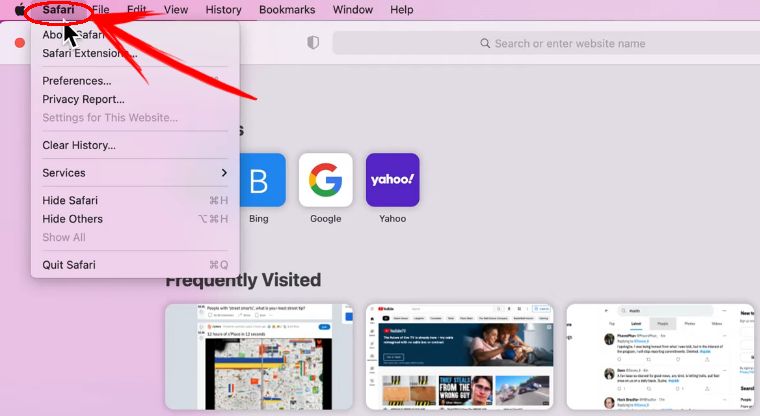
A dropdown menu will appear from which you can select “Preferences” .

Click the “Privacy” tab, which is in the top panel.

Navigate to “Cookies and Website Data” and un-tick the option “Block all cookies” . This will allow 3rd party cookies on Safari.

Allow Third-Party Cookies on iPhone/iPad iOS 11
Go to “Settings” .

Scroll down to “ Safari ” and click on it.

Under “Privacy and Security” turn off “Prevent Cross-Site Tracking ”. Also, turn off “Block All Cookies” (Turning off makes the green bar go white.)
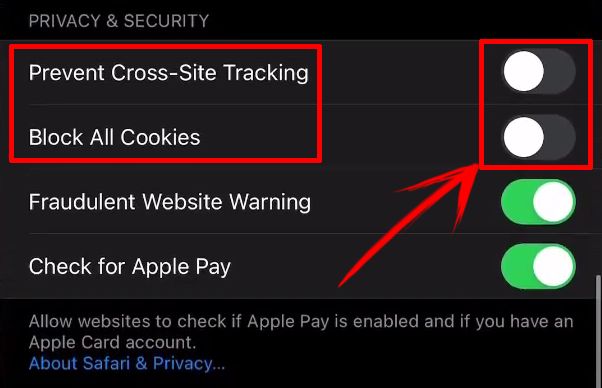
Do you know you can also use Safari to do reverse image search on Mac ?
Allow Third Party Cookies on iPad iOS 10 and others
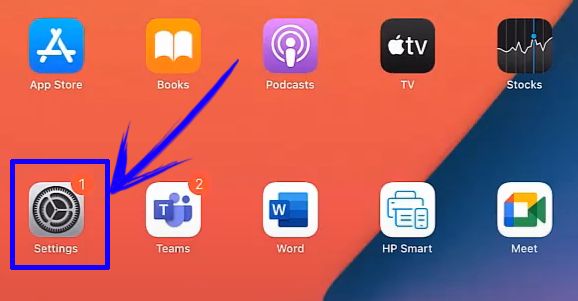
Scroll down to Safari and click on it.

Under “Privacy and Security”, click on “ Block All Cookies ” .
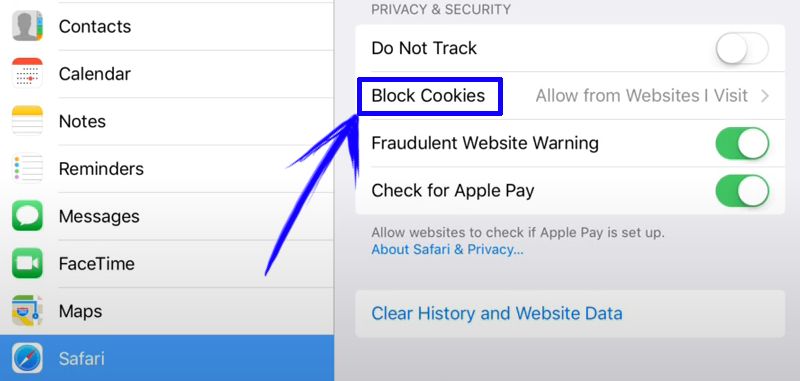
Select “Always Allow” or “Allow from Websites I Visit” from the dropdown menu. This will allow 3rd party cookies on Safari.

Safari is set to block third-party cookies automatically. However, if you use a MacBook and need the browser to stop blocking third-party cookies, you can follow the steps mentioned above to enable third-party cookies on Safari.
At step five, deselect the option “Block Cookies” under the cookies and website data. However, this option allows cookies from all websites to be displayed, which might disrupt your browsing experience.
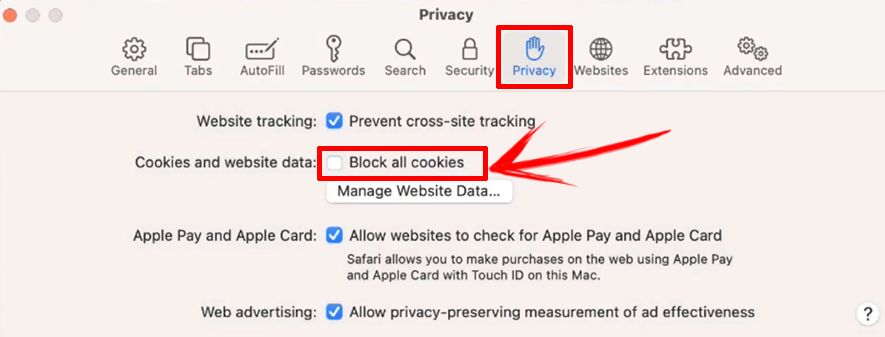
To cut down the number of websites that display cookies, you can check the option “Allow from websites I visit.” With this option, Safari won’t be able to block third-party cookies on the websites you visit frequently with this option enabled, allowing you to browse uninterrupted and conveniently.
- Change Privacy preferences in Safari on Mac
- Manage Cookies and Website Data in Safari on Mac
- 9+ Best Web Browsers for Mac
- Best Web Browsers for Apple TV
- Change Default Browser in Windows 11
- Best Database Software For Mac
Kimanthi Sammy
Kimanthi Sammy is a tech enthusiast and writer passionate about web development, design, video games, software, and tech in general. She combines creativity with technical prowess to produce captivating and informative content.
Don’t Miss…
![Chrome Extensions on iPad - How to Use Them [The Only Way] chrome extensions ipad share](https://alvarotrigo.com/blog/wp-content/uploads/2023/08/chrome-extensions-ipad-share-300x150.png)
- Legal Notice
- Terms & Conditions
- Privacy Policy
A project by Alvaro Trigo
- PRO Courses Guides New Tech Help Pro Expert Videos About wikiHow Pro Upgrade Sign In
- EDIT Edit this Article
- EXPLORE Tech Help Pro About Us Random Article Quizzes Request a New Article Community Dashboard This Or That Game Popular Categories Arts and Entertainment Artwork Books Movies Computers and Electronics Computers Phone Skills Technology Hacks Health Men's Health Mental Health Women's Health Relationships Dating Love Relationship Issues Hobbies and Crafts Crafts Drawing Games Education & Communication Communication Skills Personal Development Studying Personal Care and Style Fashion Hair Care Personal Hygiene Youth Personal Care School Stuff Dating All Categories Arts and Entertainment Finance and Business Home and Garden Relationship Quizzes Cars & Other Vehicles Food and Entertaining Personal Care and Style Sports and Fitness Computers and Electronics Health Pets and Animals Travel Education & Communication Hobbies and Crafts Philosophy and Religion Work World Family Life Holidays and Traditions Relationships Youth
- Browse Articles
- Learn Something New
- Quizzes Hot
- This Or That Game
- Train Your Brain
- Explore More
- Support wikiHow
- About wikiHow
- Log in / Sign up
- Computers and Electronics
- Operating Systems
How to Allow 3rd Party Cookies on a Mac
Last Updated: December 5, 2023 Fact Checked
This article was co-authored by wikiHow staff writer, Darlene Antonelli, MA . Darlene Antonelli is a Technology Writer and Editor for wikiHow. Darlene has experience teaching college courses, writing technology-related articles, and working hands-on in the technology field. She earned an MA in Writing from Rowan University in 2012 and wrote her thesis on online communities and the personalities curated in such communities. This article has been fact-checked, ensuring the accuracy of any cited facts and confirming the authority of its sources. This article has been viewed 54,298 times. Learn more...
When you visit a website, there’s a good chance that it’s saving your browsing patterns on your device. This information, known most commonly as “cookies,” allows websites to personalize their data to fit your specific needs. While cookies have gotten a bad rap in the media, they can actually help you find exactly what you’re looking for when you have them enabled. This wikiHow will teach you how to allow 3rd party cookies on Mac using Safari, Chrome, or Firefox.
Allowing 3rd Party Cookies on Safari

- You can also check a less liberal option, such as "Allow from websites I visit", to cut down on the number of third-party cookies on your computer.
- These cookies will make your browsing experience easier. They allow the 3rd-party elements (like ads and images) to remember your site preferences and give you locally relevant information.
Allowing 3rd Party Cookies on Chrome

- Cookies are enabled by default in Chrome. You won't have to turn them on unless you disabled them in the past.

- To allow all cookies, including those meant to track your browsing on other websites, select Allow all cookies .
- To allow all cookies except tracking cookies from third parties, select Block third-party cookies . This option may break some features on websites, but it will protect your privacy from trackers.
- To only block third-party cookies in Incognito mode , select Block third-party cookies in Incognito . This allows all cookies except when you open a new Incognito window.

Allowing 3rd Party Cookies on Firefox

- Cookies are enabled by default in Firefox. You won't have to turn them on unless you disabled them in the past.

- Standard: This option allows all cookies except for those that track you on other websites, although it will let some cross-site trackers through if they are for login or other non-predatory reasons. This option is best for most users.
- Strict: This option is similar to Standard, except it blocks all third-party cookies. This could make it difficult to log in to some websites and use certain website features.
- Custom: This option lets you choose exactly which types of cookies you want to allow and block. This option is great for power users who are familiar with different types of tracking cookies.
- Cookies will make your browsing experience easier. They allow the 3rd-party elements (like ads and images) to remember your site preferences and give you locally relevant information.
Expert Q&A
You Might Also Like

- ↑ https://support.apple.com/guide/safari/manage-cookies-and-website-data-sfri11471/mac
- ↑ https://support.apple.com/en-us/102564
- ↑ https://support.apple.com/en-us/guide/safari/ibrw850f6c51/mac
- ↑ https://support.google.com/accounts/answer/61416?hl=en&co=GENIE.Platform%3DDesktop
- ↑ https://support.google.com/chrome/answer/95647
- ↑ https://support.mozilla.org/en-US/kb/websites-say-cookies-are-blocked-unblock-them#firefox:mac:fx120
About This Article

1. Open Safari. 2. Click Safari . 3. Click Preferences . 4. Click the Privacy tab. 5. Deselect the “Block All Cookies” option. Did this summary help you? Yes No
- Send fan mail to authors
Is this article up to date?

Featured Articles

Trending Articles

Watch Articles

- Terms of Use
- Privacy Policy
- Do Not Sell or Share My Info
- Not Selling Info
wikiHow Tech Help Pro:
Level up your tech skills and stay ahead of the curve
How To Allow Third-Party Cookies on Mac for Safari, Chrome and Firefox
- It is common for most browsers to disable third-party cookies.
- Remember that cookies often invade your privacy and are typically used to target specific advertising to the user.
- Try to remember to disable these features again once you are finished.

Typically it’s a great idea to avoid third-party cookies, but some may want to know how to allow them on a Mac anyway. While this sounds insane, there are a couple of good reasons for this. For example, I was recently helping my uncle plan a vacation, and enabling cookies gave us more specific advertising on deals we were looking for. Allowing certain things to be on your Mac can sometimes be a good thing, so continue reading to explore the options.
How to Allow Third-Party Cookies with Safari
When it comes to a Mac’s native browser, there are two settings that users should change.
Time needed: 1 minute
How to enable third-party cookies in Safari:
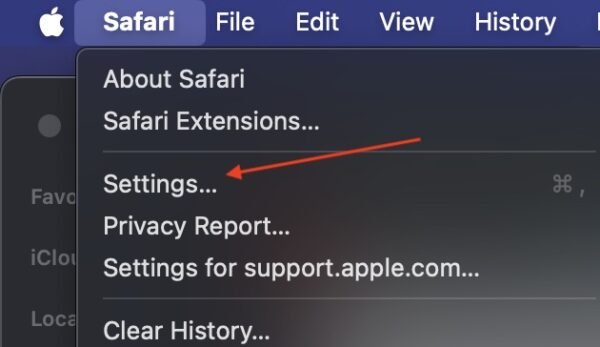
In just a few simple clicks, Safari can accept all third-party cookies.
How to Allow Third-Party Cookies with Google Chrome
Of course, Safari isn’t for everybody, so let’s take a look at how to do the same thing within Google Chrome:
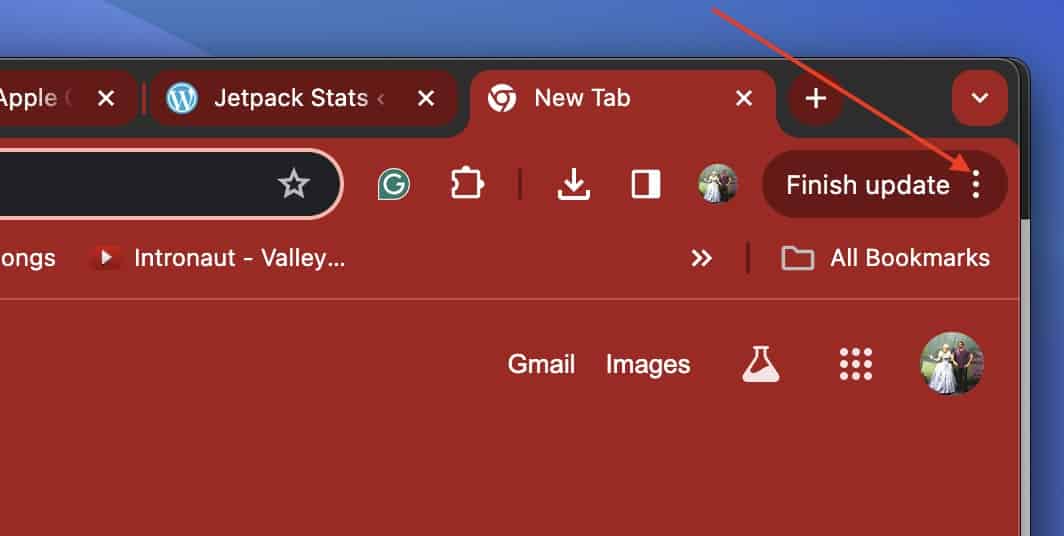
The nice thing about Google Chrome is that it allows that extra option for Incognito mode. This can be great for allowing cookies while browsing normally, yet still keeping things private when they need to be.
How to Allow Third-Party Cookies with Mozilla Firefox
Who can forget this one? Firefox is another staple within the world of alternative web browsers, as it should be. Like the other browsers before it, enabling the proper settings is as easy as a few clicks.
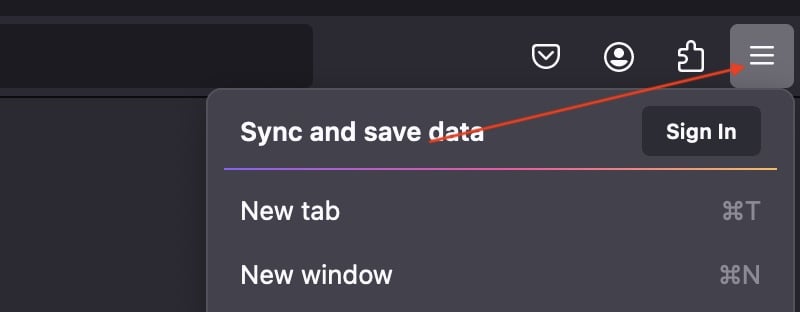
- Select Privacy & Security .
- Scroll a bit and select Custom .

Additionally, it may be of interest to read about why Mozilla decided to block third-party cookies automatically .
What About Other Browsers?
By now, astute readers should begin noticing a theme. If a user needs to enable third-party cookies in other web browsers, it’s simply a matter of exploring the Settings menu within that browser. With luck, enabling third-party cookies will most likely be within a Privacy and/or Security section. It may take some exploring, but as long as users avoid shutting things off randomly, the settings shouldn’t be too hard to find.
You may also want to know how to clear the cache of the three of the most popular Mac browsers .
Leave a Reply Cancel reply
You must be logged in to post a comment.
This site uses Akismet to reduce spam. Learn how your comment data is processed .
- Nick deCourville
How To Enable Third-Party Cookies On Safari

- Software & Applications
- Browsers & Extensions
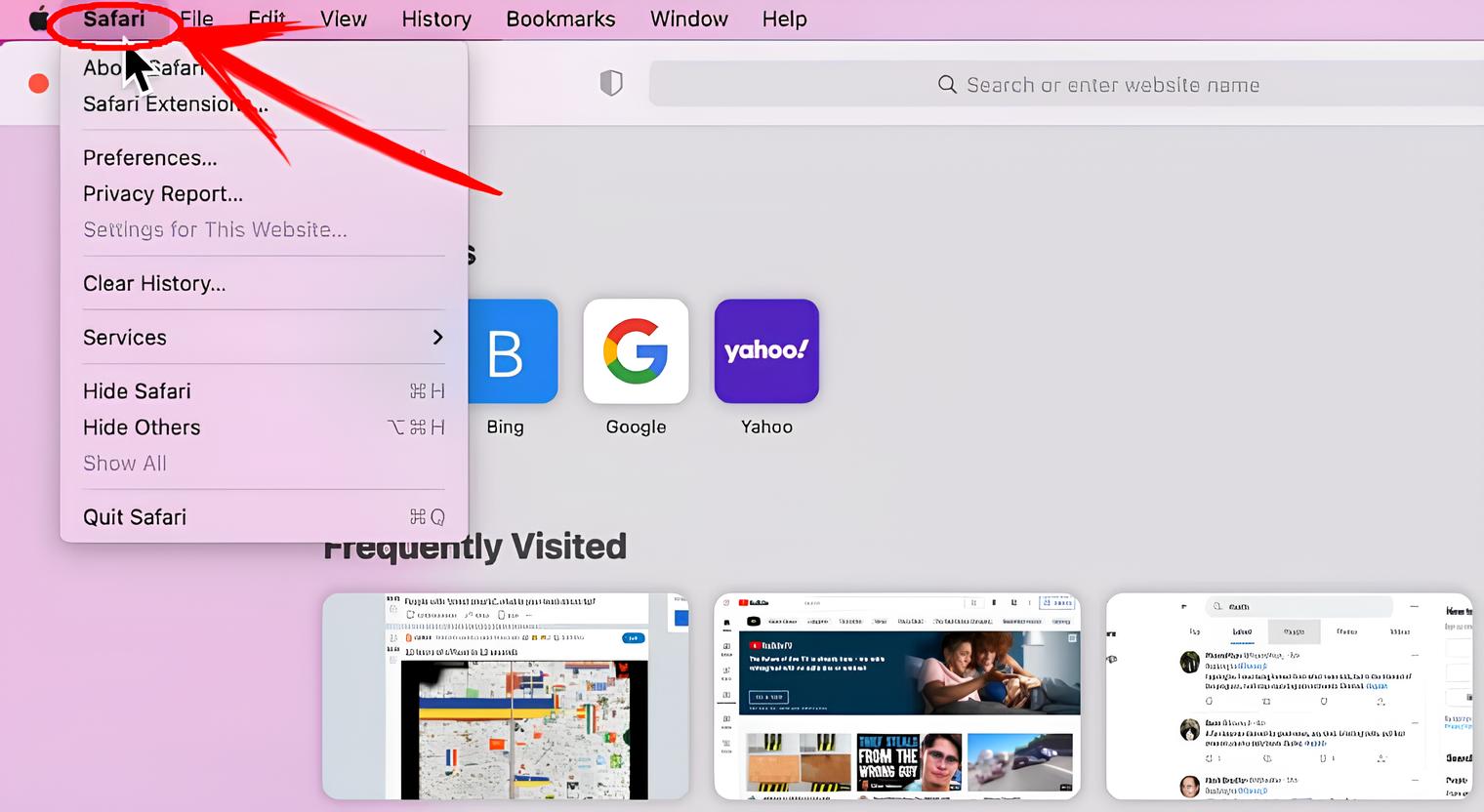
Introduction
In today's digital age, web browsers have become an integral part of our daily lives, serving as gateways to the vast realm of the internet. Among the myriad of features and settings that browsers offer, the management of cookies holds significant importance. Cookies, particularly third-party cookies, play a crucial role in tracking user behavior, personalizing online experiences, and enabling targeted advertising.
As the default web browser for Apple devices, Safari is renowned for its robust privacy and security features. However, in its pursuit of safeguarding user data, Safari has taken a strict stance on third-party cookies. By default, Safari blocks these cookies, aiming to protect user privacy and prevent cross-site tracking.
While this default setting aligns with Apple's commitment to user privacy, it can sometimes lead to a less-than-optimal browsing experience for users who rely on third-party cookies for various functionalities. Therefore, understanding how to enable third-party cookies on Safari is essential for those who wish to access certain websites and services that depend on these cookies.
In this article, we will delve into the intricacies of third-party cookies, explore the reasons for enabling them on Safari, and provide a comprehensive guide on how to do so. Whether you're a casual internet user or a web developer seeking to ensure seamless functionality across different browsers, this article will equip you with the knowledge and tools to navigate Safari's cookie settings effectively. Let's embark on this journey to unravel the world of third-party cookies and harness the full potential of Safari's browsing capabilities.
Understanding Third-Party Cookies
In the realm of web browsing, cookies serve as small pieces of data that websites store on a user's device. These data snippets are designed to facilitate various functionalities, such as remembering login credentials, personalizing content, and tracking user interactions. While first-party cookies are set by the website being visited, third-party cookies originate from domains other than the one displayed in the address bar.
Third-party cookies play a pivotal role in enabling cross-site tracking and targeted advertising. When a user visits a website that contains resources from third-party domains, such as embedded advertisements or social media plugins, these third-party domains can set cookies to track the user's activity across different sites. This tracking mechanism allows advertisers and data analytics companies to gather insights into user behavior, preferences, and browsing patterns, thereby facilitating the delivery of personalized ads and content.
From a user experience standpoint, third-party cookies contribute to the seamless functioning of various online services. For instance, they enable social media integration, allowing users to share content across platforms and interact with social plugins on different websites without the need for repeated authentication. Additionally, third-party cookies are instrumental in supporting e-commerce functionalities, such as retaining items in a shopping cart across multiple sites and providing personalized product recommendations based on browsing history.
However, the pervasive use of third-party cookies has raised concerns about user privacy and data security. Critics argue that the extensive tracking facilitated by these cookies can lead to intrusive profiling and potential exploitation of personal information. In response to these concerns, major web browsers, including Safari, have implemented measures to restrict or block third-party cookies by default, aiming to enhance user privacy and mitigate the risks associated with cross-site tracking.
By understanding the role of third-party cookies in web browsing, users can gain insights into the trade-offs between personalized experiences and privacy protection. This understanding is particularly relevant when navigating Safari's cookie settings, as it empowers users to make informed decisions about enabling or disabling third-party cookies based on their preferences and requirements.
Why Enable Third-Party Cookies on Safari
Enabling third-party cookies on Safari can significantly enhance the functionality and user experience across various websites and online services. While Safari's default setting of blocking third-party cookies aligns with its commitment to user privacy, there are compelling reasons why users may choose to enable these cookies in certain scenarios.
Seamless Cross-Site Functionality
Many websites rely on third-party cookies to deliver seamless cross-site functionality. For instance, social media integration features, such as the ability to share content and interact with social plugins across different websites, often depend on third-party cookies. By enabling these cookies, users can experience uninterrupted social media interactions and sharing capabilities, without encountering authentication hurdles at every turn.
Enhanced Personalization
Third-party cookies play a pivotal role in delivering personalized content and recommendations across the web. By tracking user behavior and preferences across multiple sites, these cookies enable platforms to tailor content, advertisements, and product recommendations to individual users' interests. Enabling third-party cookies on Safari can thus lead to a more personalized and relevant online experience, particularly when engaging with e-commerce websites, content platforms, and personalized advertising networks.
Uninterrupted E-Commerce Functionality
In the realm of online shopping, third-party cookies are instrumental in maintaining a seamless e-commerce experience. These cookies enable features such as retaining items in a shopping cart across different sites, providing personalized product recommendations based on browsing history, and facilitating streamlined checkout processes. By enabling third-party cookies on Safari, users can ensure that their e-commerce interactions remain smooth and uninterrupted, without encountering obstacles related to cross-site functionality.
Access to Certain Services and Platforms
Some websites and online services may have functionalities that rely on third-party cookies for essential operations. By enabling these cookies on Safari, users can gain access to specific platforms, features, or content that require the utilization of third-party cookies. This can be particularly relevant for individuals who rely on Safari as their primary web browser and encounter limitations in accessing certain services due to the default blocking of third-party cookies.
In essence, enabling third-party cookies on Safari empowers users to unlock a myriad of cross-site functionalities, personalized experiences, and seamless interactions across various online platforms. By carefully considering the implications and benefits of enabling these cookies, users can make informed decisions that align with their preferences and browsing requirements.
Steps to Enable Third-Party Cookies on Safari
Enabling third-party cookies on Safari involves navigating through the browser's settings to modify the default cookie preferences. By following the steps outlined below, users can adjust Safari's cookie settings to allow the use of third-party cookies, thereby unlocking enhanced cross-site functionality and personalized experiences.
Open Safari Preferences : Begin by launching the Safari browser on your Apple device and accessing the "Safari" menu located in the top-left corner of the screen. From the drop-down menu, select "Preferences" to open the Safari Preferences window.
Navigate to Privacy Settings : Within the Safari Preferences window, click on the "Privacy" tab, which houses various privacy and security settings related to browsing data and cookies.
Adjust Cookie Settings : Under the Privacy tab, locate the "Cookies and website data" section. By default, Safari blocks third-party cookies for privacy and security reasons. To enable third-party cookies, uncheck the box next to "Block all cookies." This action will allow both first-party and third-party cookies to be stored on your device.
Confirm the Changes : After unchecking the "Block all cookies" option, Safari will prompt you to confirm the changes to the cookie settings. Click "Allow" or "Allow from websites I visit" to finalize the modification. This step ensures that third-party cookies are permitted, while still maintaining control over which websites can store cookies on your device.
Restart Safari : To ensure that the changes take effect, it is advisable to restart the Safari browser. Close the browser window and relaunch Safari to initiate the updated cookie settings.
Verify Third-Party Cookie Usage : Once Safari has been restarted, visit websites or online platforms that rely on third-party cookies for various functionalities. By allowing these cookies, you should experience seamless cross-site interactions, personalized content, and enhanced e-commerce features that were previously impacted by the default blocking of third-party cookies.
By following these steps, users can effectively enable third-party cookies on Safari, thereby expanding the scope of cross-site functionalities and personalized experiences available while browsing the web. It is important to note that while enabling third-party cookies can enhance certain aspects of the browsing experience, users should remain mindful of privacy implications and exercise caution when interacting with third-party content across different websites.
In conclusion, the management of third-party cookies on Safari presents users with a delicate balance between privacy protection and the facilitation of seamless cross-site functionalities and personalized experiences. While Safari's default setting of blocking third-party cookies underscores its commitment to safeguarding user privacy, there are compelling reasons why users may opt to enable these cookies in specific contexts.
By understanding the role of third-party cookies in web browsing and the potential benefits of enabling them, users can make informed decisions tailored to their browsing requirements. The steps to enable third-party cookies on Safari, as outlined in this article, provide a clear pathway for users to adjust their cookie settings and unlock enhanced cross-site functionalities, personalized content, and uninterrupted e-commerce experiences.
It is crucial for users to approach the enabling of third-party cookies on Safari with a nuanced perspective, considering the trade-offs between functionality and privacy. While enabling these cookies can enhance certain aspects of the browsing experience, users should remain vigilant about the potential implications for their privacy and data security. Additionally, exercising caution when interacting with third-party content across different websites is essential to mitigate the risks associated with extensive cross-site tracking.
Ultimately, the decision to enable third-party cookies on Safari rests on individual preferences, browsing habits, and the specific requirements of websites and online services. By empowering users with the knowledge and tools to navigate Safari's cookie settings effectively, this article aims to foster a balanced approach to managing third-party cookies, where users can harness the benefits of enhanced functionalities while maintaining a vigilant stance on privacy protection.
As the digital landscape continues to evolve, the discourse surrounding third-party cookies and user privacy remains a dynamic and evolving domain. Safari's stance on third-party cookies reflects the broader industry-wide efforts to strike a harmonious balance between user privacy and the seamless delivery of online experiences. By staying informed and proactive in managing cookie settings, users can navigate the digital realm with confidence, leveraging the capabilities of Safari while upholding their privacy preferences.
In essence, the journey to enable third-party cookies on Safari is not merely a technical adjustment but a nuanced exploration of the intersection between privacy, functionality, and user empowerment. As users navigate this terrain, they are poised to shape their browsing experiences in alignment with their values and preferences, thereby contributing to a more informed and conscientious digital ecosystem.
Leave a Reply Cancel reply
Your email address will not be published. Required fields are marked *
Save my name, email, and website in this browser for the next time I comment.
- Crowdfunding
- Cryptocurrency
- Digital Banking
- Digital Payments
- Investments
- Console Gaming
- Mobile Gaming
- VR/AR Gaming
- Gadget Usage
- Gaming Tips
- Online Safety
- Software Tutorials
- Tech Setup & Troubleshooting
- Buyer’s Guides
- Comparative Analysis
- Gadget Reviews
- Service Reviews
- Software Reviews
- Mobile Devices
- PCs & Laptops
- Smart Home Gadgets
- Content Creation Tools
- Digital Photography
- Video & Music Streaming
- Online Security
- Online Services
- Web Hosting
- WiFi & Ethernet
- Browsers & Extensions
- Communication Platforms
- Operating Systems
- Productivity Tools
- AI & Machine Learning
- Cybersecurity
- Emerging Tech
- IoT & Smart Devices
- Virtual & Augmented Reality
- Latest News
- AI Developments
- Fintech Updates
- Gaming News
- New Product Launches
- A Indstria 40 Realizing Isaac Asimov8217s Dream in the Age of Robots
Learn To Convert Scanned Documents Into Editable Text With OCR
Related post, how to make stairs planet coaster, how to rotate camera in planet coaster, how to make a good roller coaster in planet coaster, where is the minecraft folder, how to update minecraft windows, how to update minecraft education edition, related posts.

How Do I Allow 3Rd Party Cookies On Safari

How To Enable Cookies In Safari On Mac
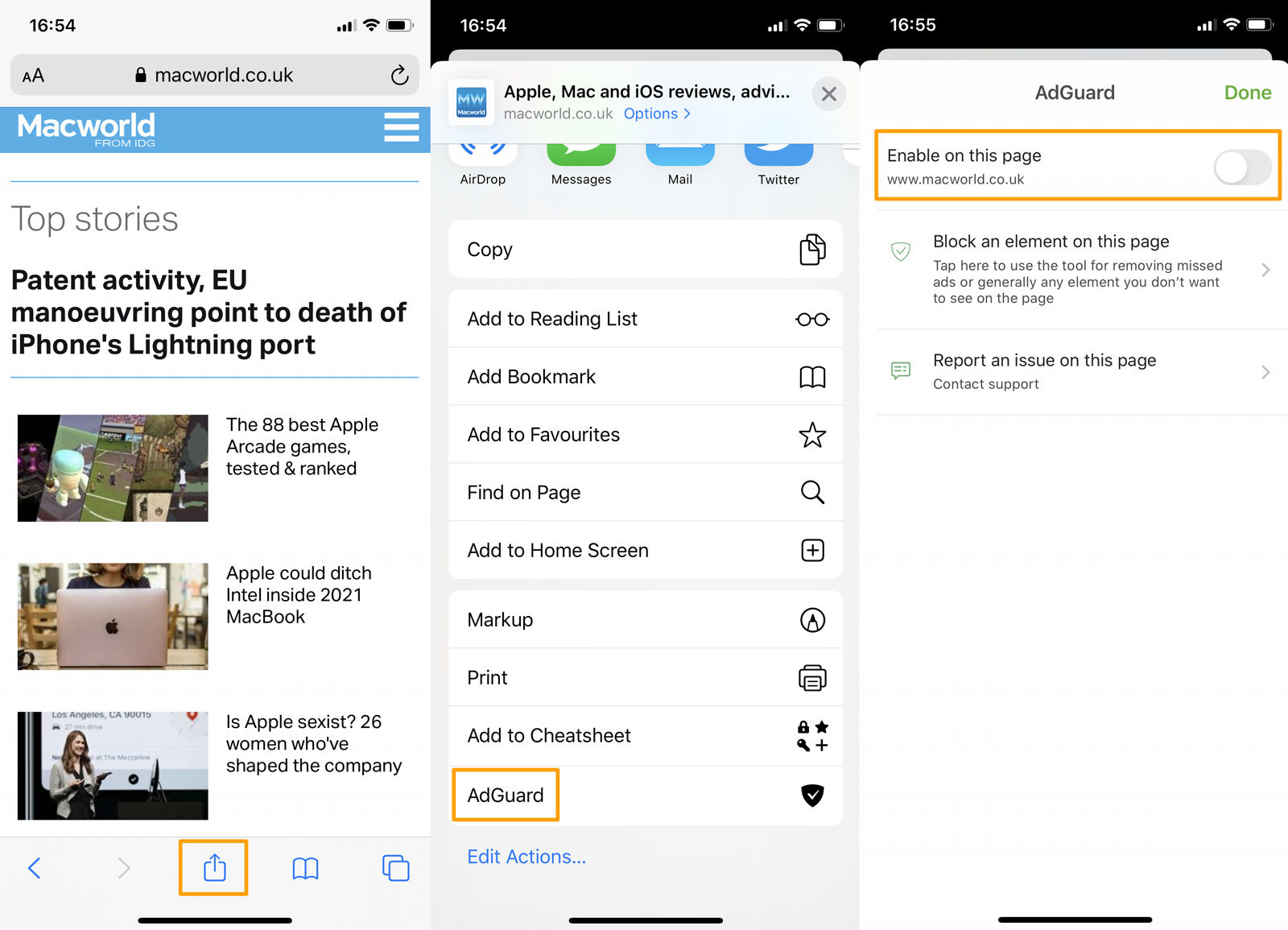
How To Get Rid Of Ads On IPad Safari
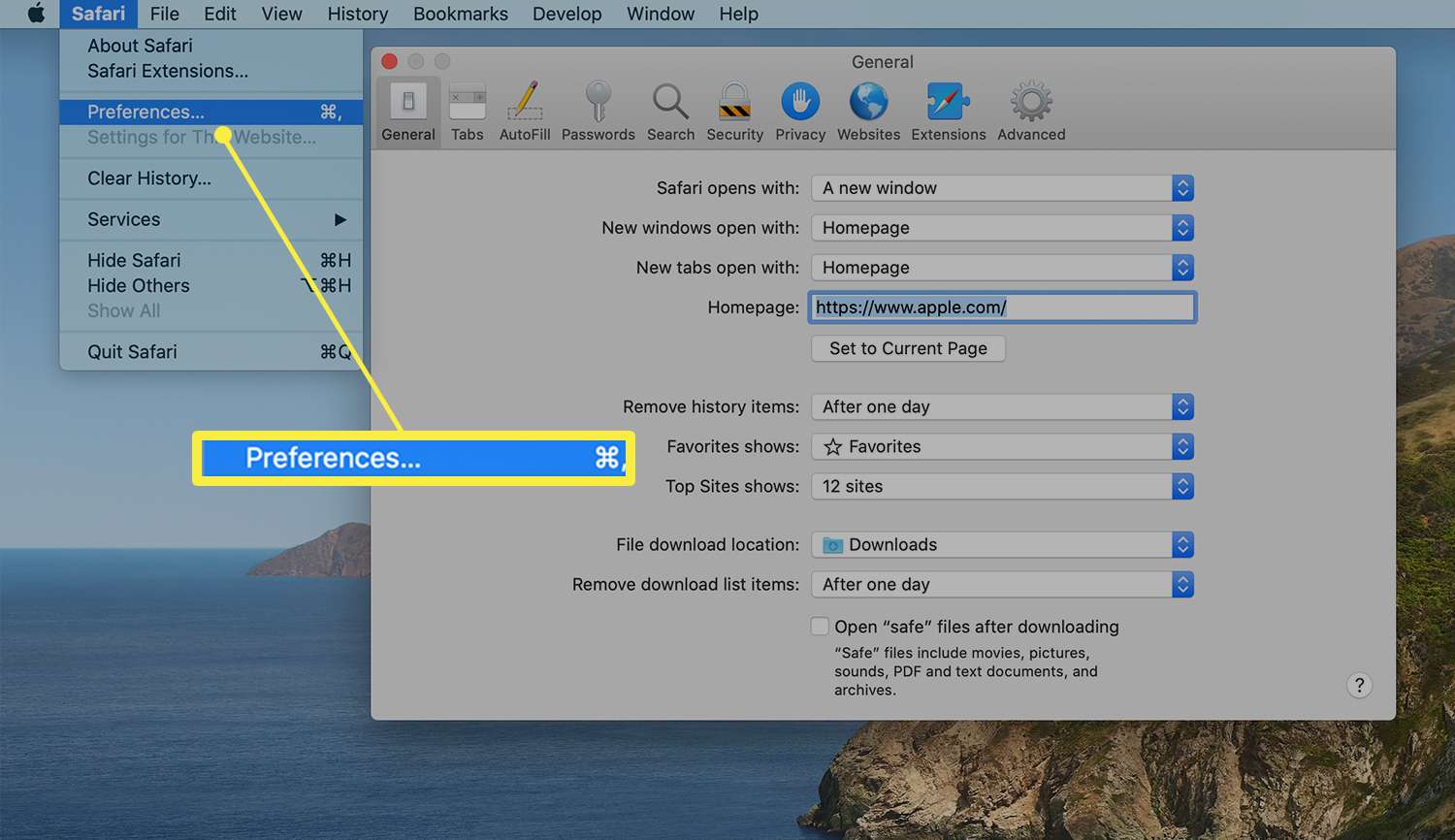
How To Turn Off Cookies In Safari
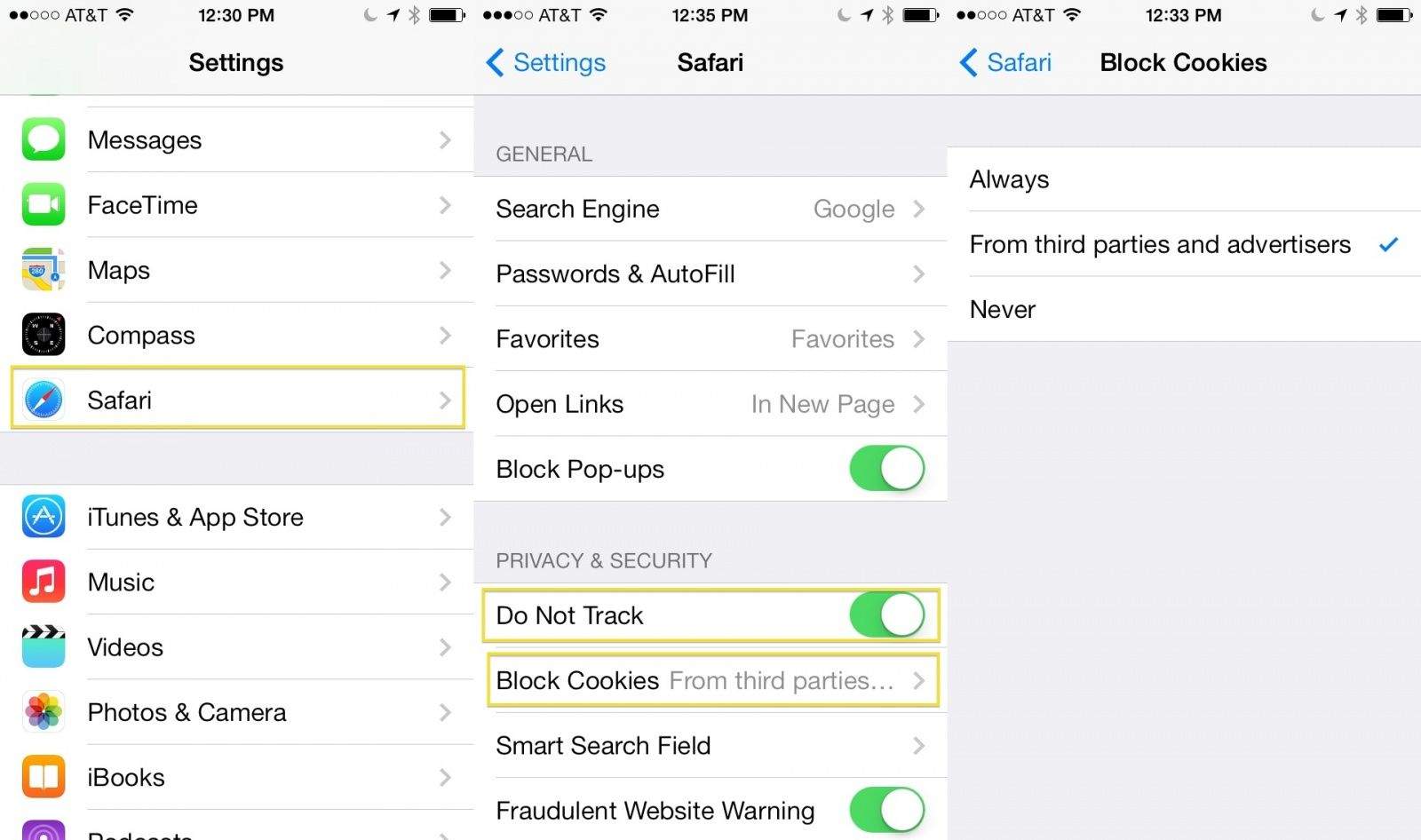
How To Block Cookies In Safari

How To Block All Cookies In Safari
What Is Cross-Site Tracking In Safari
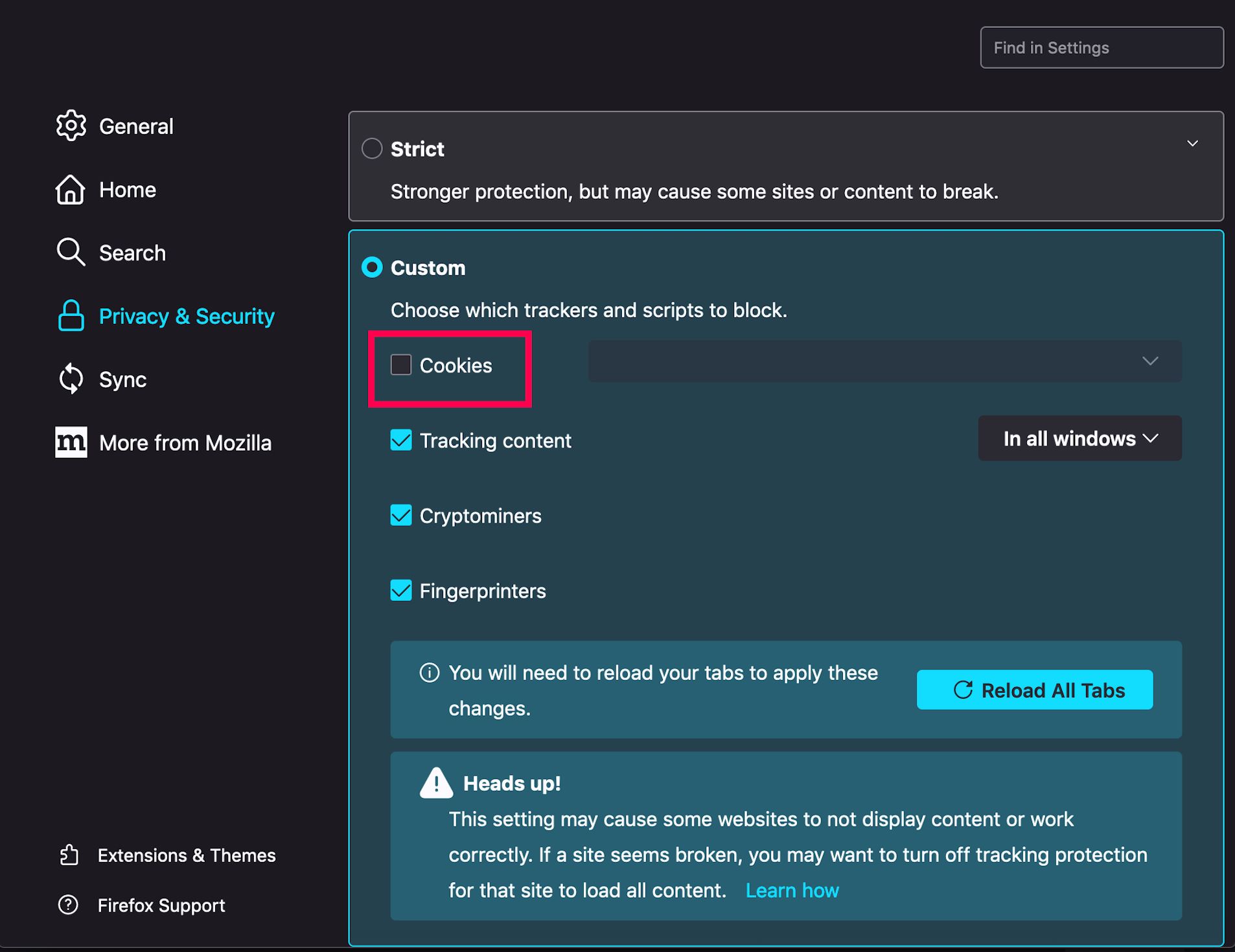
How To Allow Cookies In Browser
Recent stories.

A Indústria 4.0: Realizing Isaac Asimov’s Dream in the Age of Robots

Top Mini Split Air Conditioner For Summer

Comfortable and Luxurious Family Life | Zero Gravity Massage Chair

Fintechs and Traditional Banks: Navigating the Future of Financial Services

AI Writing: How It’s Changing the Way We Create Content

How to Find the Best Midjourney Alternative in 2024: A Guide to AI Anime Generators

How to Know When it’s the Right Time to Buy Bitcoin

- Privacy Overview
- Strictly Necessary Cookies
This website uses cookies so that we can provide you with the best user experience possible. Cookie information is stored in your browser and performs functions such as recognising you when you return to our website and helping our team to understand which sections of the website you find most interesting and useful.
Strictly Necessary Cookie should be enabled at all times so that we can save your preferences for cookie settings.
If you disable this cookie, we will not be able to save your preferences. This means that every time you visit this website you will need to enable or disable cookies again.
How to Enable Cookies in Any Mac Browser
Is your browser blocking cookies when you don't want it to?
Key Takeaways
- Enabling cookies in your Mac's browser is important for many websites to function properly and store important information.
- Safari users can enable cookies by going to Safari settings, navigating to the Advanced tab, and unchecking the Block all cookies box.
- Other browsers like Chrome, Firefox, and Microsoft Edge also offer options to enable cookies in their privacy settings, allowing for customization and fine control over cookie preferences.
Websites often store small text files on your Mac. While these files, AKA cookies, could raise privacy concerns, many sites will not function properly without them. So, whether you use Safari, Chrome, or Firefox, here's how to enable cookies in your Mac's browser.
While Safari's tracker prevention tool is often best left on, not allowing any cookies can be problematic. Many websites rely on cookies to store important information relating to preferences and account details, and blocking them can create a negative user experience and make some pages slow or completely nonfunctional.
You can enable cookies in Safari using these steps:
- Launch Safari .
- Head to the Advanced tab in the window.
You can also click the Manage Website Data button in the Privacy section of Safari settings to either remove individual cookies you don't want stored on your Mac or clear out all the cookies on Safari. The tool has a search function, so you can easily locate files related to a particular website and delete them if necessary.
Google Chrome
If you use Chrome instead of Safari as the default browser on your Mac, follow these steps to enable cookies:
- Launch Google Chrome .
- Click Chrome in the menu bar and choose Settings .
- Select Privacy and security in the left sidebar.
If you scroll down to the bottom of the same menu, you'll see the option to allow specific sites to use third-party cookies for greater control. Before you alter any settings, you may want to see our guide on Chrome's cookies policy .
Mozilla Firefox
If you're someone who uses Firefox instead of Chrome, you can enable third-party cookies in a similar way by following these simple steps:
- Launch Firefox and click Firefox in the menu bar.
- Select Settings from the dropdown to open up Firefox's settings.
- Click Privacy & Security in the left sidebar.
Firefox also has a tool for blocking or allowing cookies from certain websites. You'll find these settings when you click the Manage Exceptions button under the Cookies and Site Data section in the same menu.
Microsoft Edge
Thanks to the switch to Chromium, Microsoft Edge has gained popularity in recent years. And if you're someone who uses it, here's what you need to do on your Mac to enable cookies on Microsoft Edge:
- Launch Microsoft Edge .
- Click Microsoft Edge in the menu bar and choose Settings .
- Go to Cookies and Site Permissions in the side menu.
- Select Manage and delete cookies and site data on the right.
Further down the page, you'll find a Block and Allow list where you can add specific sites for finer control.
Allow Third-Party Cookies in Less Common macOS Browsers
As you can see, you'll generally find your cookies settings within your browser's privacy settings. If you still can't locate the appropriate setting in your browser, you may need to check the developer's website for more information.
Cookies Are Necessary for Browsing the Web
Cookies aren't necessarily harmful. While many aim to gather personal information and track you across the internet, others are crucial to helping websites work as intended. In fact, cookies help save your preferences, so you don't have to add them each time you visit.
In most cases, you can allow third-party cookies without any serious security risks. Most browsers offer intuitive options within their privacy settings that let you quickly alter and customize your preferences.
iOS 17 – How to Allow iPhone Safari Cookies
You can allow cookies on your iPhone in iOS 17 by going to Settings > Safari > Advanced > and turning off the Block All Cookies option.
Our tutorial continues below with more information on the iPhone Safari cookie setting, including pictures of these steps.
You can also watch this video about how to allow cookies on iPhone in iOS 17 for more on this topic.
How to Stop Blocking Cookies in iOS 17 (Guide with Pictures)
The steps in this article were performed on an iPhone 14 Plus in the iOS 17 operating system.
The see steps will work for more other iPhone models that are using iOS 17.
Step 1: Open the Settings app on your iPhone.

Step 2: Scroll down and choose the Safari option.
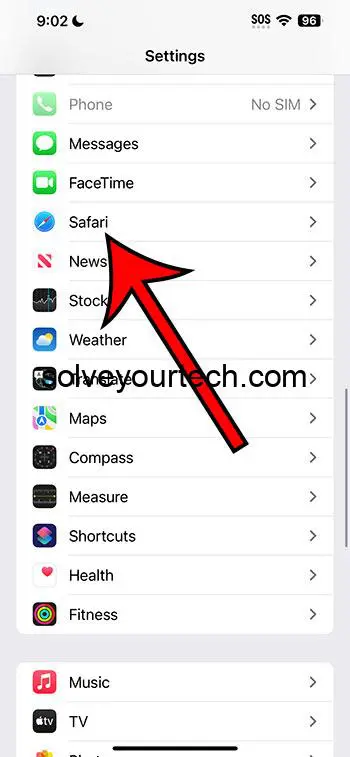
Step 3: Scroll to the bottom of the screen and select the Advanced option.
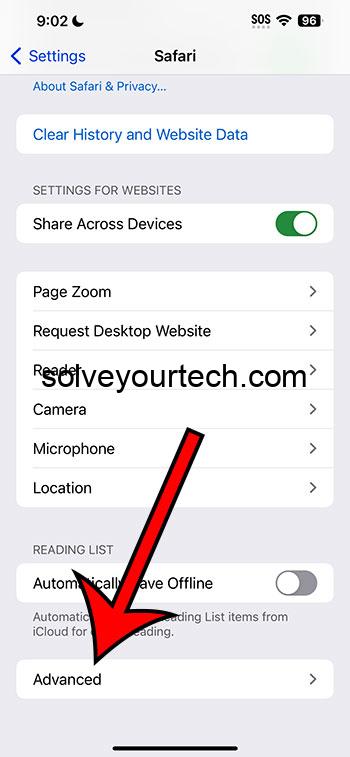
Step 4: Tap the button to the right of Block All Cookies to turn it off.
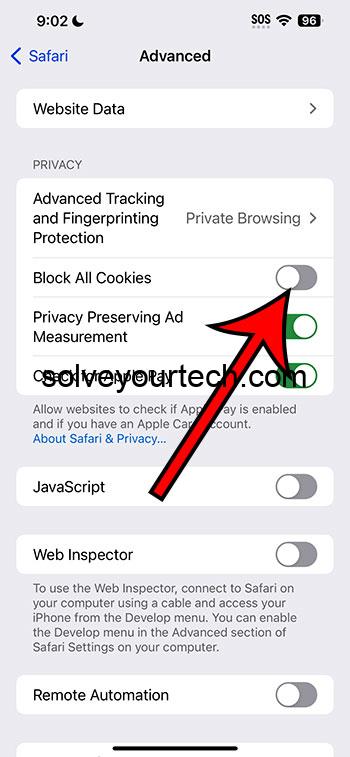
Note that this will not affect cookies in other browsers that you might have on your iPhone, such as Chrome or Firefox.
If you are using a version of iOS prior to iOS 17, then you can read this article about enabling cookies on an iPhone .
Video About the iOS 17 Safari Cookie Setting
Summary – Allowing iPhone Cookies
- Open Settings .
- Select Safari .
- Choose Advanced .
- Turn off Block All Cookies .
Related: iPhone Guide to Updating Apps
Additional Information About iPhone Cookies
Let’s talk about cookies. No, not the kind you eat with milk! I’m talking about the tiny pieces of data websites store on your device. If you’ve got an iPhone, you’ve probably seen messages about cookies popping up while browsing. So, what’s the deal? Are they good, bad, or just plain confusing? Let’s break it down.
A Crumbly Introduction to Cookies
Imagine walking into your favorite store and the salesperson remembers your name, what you last bought, and even your favorite color. It feels pretty special, right? That’s sort of what cookies do for websites. They help sites remember stuff about you, making your online experience smoother. When a website remembers your login details, shopping cart items, or settings, that’s cookies working their magic.

Why Would I Want to Allow Cookies on My iPhone?
Smooth Sailing : Websites use cookies to make things faster and easier. Hate typing in your username and password every single time? Cookies have your back!
Personal Touch : Ever noticed ads or content that seem like they were picked just for you? Cookies help websites tailor things to your taste.
Remember the Details : Whether it’s saving items in a shopping cart or keeping track of your progress in a game, cookies store these little details.
Sounds Great, But Are There Any Downsides?
Of course, like everything, cookies have a flip side. Sometimes, they can be a tad nosy. If you’re someone who values privacy, you might not like the idea of websites tracking what you’re up to. And let’s be real, nobody likes too many ads. Cookies can lead to a lot of personalized ads, which can sometimes feel overwhelming.
What happens if I block all cookies?
When you block all cookies, websites may not function as intended. You might need to sign in every time or some features might not work.
Can I choose which websites save cookies?
Yes! Safari on iPhone lets you choose which sites you trust. This is a middle ground between blocking all cookies and allowing them everywhere.
Do cookies harm my iPhone?
Cookies themselves are harmless. They’re just data. But, if a website is shady, it might misuse cookies. It’s always good to only allow cookies from sites you trust.
How often should I clear cookies from my iPhone?
Clearing cookies is like spring cleaning. You can do it whenever you feel your browsing is getting cluttered. Some folks do it monthly, while others, only when there’s an issue.
What’s the difference between cookies and cache?
While cookies store details about your interactions, cache is like a memory bank that helps websites load faster. They’re both there to make your life easier, but they do different things.
More About Cookies
For those who dive deep, there’s more to cookies than meets the eye. There are various types like session cookies, which vanish once you close your browser, and persistent cookies that hang around longer. Plus, there’s a difference between first-party cookies (from the site you’re on) and third-party cookies (from advertisers or others). You can even dive into settings on your iPhone to tweak these specifics if you’re feeling adventurous.
In conclusion, cookies on your iPhone can be friends or foes – it all depends on how you see them. They sure make life online easier, but if privacy is your jam, you’ve got controls in your hands. Either way, now you’re equipped with the knowledge to make an informed choice. So, to allow or not to allow? The cookie crumbles in your court!

Matthew Burleigh has been writing tech tutorials since 2008. His writing has appeared on dozens of different websites and been read over 50 million times.
After receiving his Bachelor’s and Master’s degrees in Computer Science he spent several years working in IT management for small businesses. However, he now works full time writing content online and creating websites.
His main writing topics include iPhones, Microsoft Office, Google Apps, Android, and Photoshop, but he has also written about many other tech topics as well.
Read his full bio here.
Share this:
Join our free newsletter.
Featured guides and deals
You may opt out at any time. Read our Privacy Policy
Related posts:
- How to Clear Cookies on iPhone
- How to Allow Cookies on iPhone 14
- 15 Ways to Fix Safari Not Working on iPhone in 2023
- How to Block All Cookies on iPhone 15: A Step-by-Step Guide
- How to Allow Cookies on iPhone 15: A Step-by-Step Guide
- How to Block Cookies on iPhone 14: A Step-by-Step Guide
- How Can I Remove Safari Cookies on an iPhone 14?: A Step-by-Step Guide
- How to Always Allow Cookies in the Safari iPhone Browser
- Safari History iPhone: How to See It [2023 Guide]
- Can I Delete the Cookies on My iPhone 11? Here’s How
- How to Delete Cookies on iPhone 12
- Why Would I Want to Delete Cookies on iPhone 13?: Privacy & Performance
- How to Clear Your Cookies in the iPhone 5 Safari Browser
- What Happens If I Delete My iPhone 12 Cookies?: Consequences Explained
- How to Get Safari Back on iPhone 13
- Where Do I Find and Delete My iPhone 15 Cookies?: A Step-by-Step Guide
- How to Block Cookies on the iPhone
- 15 iPhone Settings You Might Want to Change
- How to Enable Cookies on iPhone 13
- iOS 17: How to Clear Cookies on iPhone in Simple Steps
Enable Cookies in Safari
Updated at: Feb 19, 2022
This guide will step you through the process of getting Cookies enabled in Safari on macOS.
Enable Cookies
Click the "safari" menu.
Make sure you have a Safari window open and active; you will see the "Safari" menu in the top left of your screen. Click it and it will expand to show Safari specific options.

Click the "Preferences" menu item
Now that you have expanded the Safari menu, you will see the Preferences item - click on it.

The Safari Preferences screen will now appear.
Click the "Privacy" tab
The Safari Preferences screen has a number of sections, indicated by the various options along the top of the screen (General/Tabs/AutoFill etc). Click the Privacy item to see privacy related options.
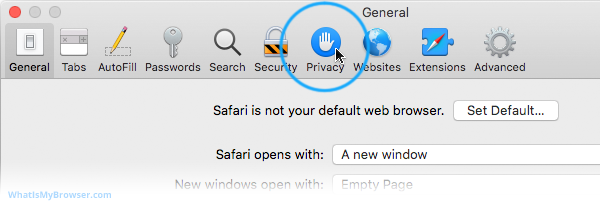
Choose your preferred Cookies and tracking settings
On the Privacy Preferences tab, you will see the " Website tracking: " and " Cookies and website data: " checkboxes.

Enabling Prevent cross-site tracking blocks third-party cookies from being set as well as third-party websites from storing data on your computer. Enabling this option is a good step in helping prevent companies from tracking your activity online.
Enabling Block all cookies will prevent block First-Party cookies, as well as Third-Party cookies. Enabling this may cause websites to not work properly, and Safari will warn you about this if you choose this option.
A good balance of settings is to enable Prevent cross-site tracking and disable Block all cookies .
If you click the Manage Website Data button you'll see a list of website domains which have stored data on your computer. You can remove some or all of them.
Close the Preferences window
Once you have configured your cookie blocking preferences, you can simply close this window and continue using Safari.

Congratulations, you just configured Cookies in Safari. Click here to check if Cookies are enabled.
You may also want to take a moment to clear your cookies and history in Safari .
Safari and Third-Party Cookies
After extensive testing and debugging, we have found that when you enable Block cross-site tracking in Safari it will still hold on to the third-party cookies and keep using them until you restart Safari.
So if you choose to enable Block cross-site tracking in Safari, make sure you restart (and preferably Reset Safari) to ensure that it doesn't keep using any third party cookies it may have cached.
More guides and help for Safari
Need more help with Safari? Read our other Safari guides .
Clear cache & history
Do i need to clear my cache.
Not sure why you've been asked to clear your cache? We can explain. Why you need to clear your cache
What is a cache?
Before you consider clearing your browser cache, you should know what it is! Learn a little bit about browser caches
Is it safe to clear my cache?
Are there any risks to clearing your cache? Find out if it's ok to clear your cache
Update my web browser
Do i need to update my browser.
Find out if your browser is out of date Is my browser out of date?
Why should I update my browser?
There are very good reasons to, find out here! Why update your browser?
Is it free to update Chrome?
Find out about the cost of updating Chrome... Does Chrome cost anything?
What does "Update browser" mean?
What does it actually mean? What does it mean to update your browser
Get help with our guides
How to enable javascript.
Change your JavaScript settings Guide to enabling Javascript
How to enable Cookies
Configure your cookie settings for privacy Guide to enabling cookies
Related articles
I can't log in to a website..
We've got a detailed guide to help you solve login problems How to fix website log in problems
Why do websites use cookies?
Why are cookies useful? Do you need them? What's the deal with cookies?
How to update your browser
Old software puts you at risk. Keep your browser fresh and up to date
Clear Cache, Cookies and History
How to reset your browsing history How to reset your browser
Try a different web browser
Different web browsers have different features - try a different one to see if you prefer it. Experiment a bit!
Use a VPN to hide your IP address
We recommend NordVPN to hide your IP address or to unblock websites. Hide your IP Address
Higher Ed and Technology: Academics at Chapman
Enable Third-Party Cookies in Safari Fix problems downloading files, using 3rd party tools, and viewing videos in Canvas
December 10, 2020
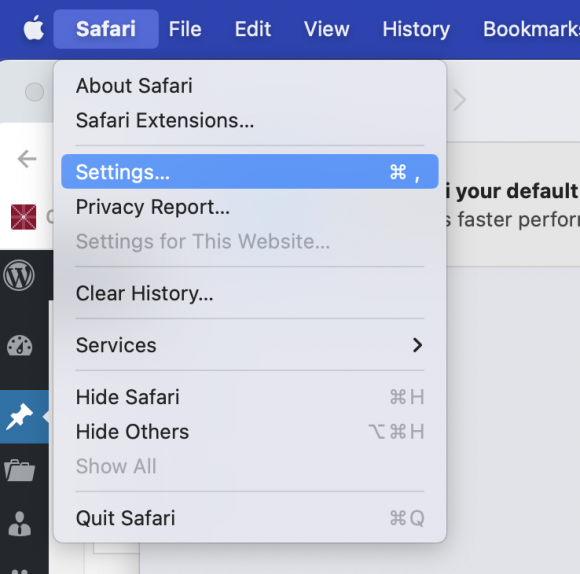
Enable Third Party Cookies for Safari on iOS
Please note: As of Safari 13.1 and later, third-party cookies are blocked by default, will break an embedded video, and prevent file downloads. For more information, visit Webkit’s article: Full Third-Party Cookie Blocking and More .
iOS 11 to current
More Stories

End of Semester Canvas Checklist
April 29, 2024 by Shannon Muramoto | Canvas
✔️Put in Zeros for Missing Assignments If students are missing assignments, you will need to put in zeros for those missing assignments. The easiest way to do this is to open your Grade Center and look for empty grade cells. Some instructors may also use the Missing Submission Policy in the gradebook settings. Resource: How do I enter

How Can I Make My Canvas Quizzes More Secure and Promote Academic Integrity?
February 26, 2024 by Elena Marusak | Canvas
Dear Chapman Instructors, If you are using Canvas to deliver quizzes and exams, you may be wondering how you can make your Canvas quizzes more secure and promote academic integrity. Below are some steps you can take as you are building your quiz questions, choosing your settings, and proctoring the quiz. Randomize the Question Order
- Panther Mail
- Staff & Faculty Email
- Campus Life
- Prospective Students
- Current Students
- Faculty & Staff
- Parents & Families
- Degrees & Programs
- Argyros School of Business & Economics
- Attallah College of Educational Studies
- College of Performing Arts
- Crean College of Health & Behavioral Sciences
- Dodge College of Film & Media Arts
- Fowler School of Engineering
- Fowler School of Law
- Schmid College of Science & Technology
- School of Communication
- School of Pharmacy
- Wilkinson College of Arts, Humanities, & Social Sciences
- News and Stories
- Chapman Alumni
- Crean College of Health and Behavioral Sciences
- Dodge College of Film and Media Arts
- Schmid College of Science and Technology
- Wilkinson College of Arts, Humanities, and Social Sciences
- View More Blogs
- Inside Chapman
How to enable third-party cookies in your browser
- Knowledge Base
- Variant Option Product Options
- 1. Microsoft Internet Explorer
- 2. Microsoft Edge
- 4. Google Chrome for Desktop
- 5. Google Chrome on Android
- 6. Apple Safari on OS X
- 7. Apple Safari on iOS
To turn on third-party cookie blocking, click the gear icon in the upper-right corner, then click “Internet Options” from the drop-down list.
Click the “Privacy” tab and set it to “Medium High”. This will block all third-party cookies.
When you’ve finished, click on the “OK” button to exit the Internet Options and commit the changes.
If you use the new Edge browser on Windows 10, then tap or click on the three dots in the upper-right corner of the browser window. Select “Settings” at the bottom of the menu.
In the settings, tap or click on “View advanced settings”.
Now, in the advanced settings, under the Cookies heading, click the drop-down menu and select “Block only third party cookies”.
Close out the settings and Edge will now block third-party cookies.
On Firefox, click the three lines in the upper-right corner, then click “Preference”.
With the preferences open, note that there’s an option to turn on Firefox’s Do Not Track option. Below the Tracking preferences, click “Remember History” and then select “Use custom settings for history” option.
From the custom history settings screen, click the drop-down list next to “Accept third-party cookies” and then choose “Never”.
Your changes will be implemented immediately, so there’s no “OK” or “Apply” button to click.
On Chrome for desktops, click the three lines in the upper-right corner, then click “Settings”.
Scroll to the bottom of the settings and click “Show advanced settings” at the bottom of the settings screen.
On the advanced settings screen, click “Content settings…” under the Privacy heading.
With the content settings open, click the box next to “Block third-party cookies and site data”.
That’s it–you’re done, you can close the settings tab and go back to your regular browsing activities.
When you want to block third-party cookies on Chrome for Android, you need to click the three dots in the upper-right corner and choose “Settings” from the drop-down menu.
Under the Advanced heading, you’d think what you’re looking for would be in the Privacy settings…
…but all you will find in here worth noting is the Do Not Track option. If you don’t have it turned on, you might as well enable it now.
In order to designate which Cookies are allowed, you need to tap on “Site Settings” in the Advanced options, then tap “Cookies”.
In the Cookies settings, all you do is deselect “Allow third-party cookies”.
That’s it. Simply exit out of the settings and you’re done.
On Safari for OS X, you will need to open the Preferences by clicking on the Safari menu, or using the old standard keyboard shortcut “Command + ,”.
With the preferences open, click the “Privacy” tab, then under “Cookies and website data” click “Allow fro current website only”. At the bottom of the Privacy tab, there’s also an option to turn on Safari’s Do Not Track feature.
Exit out of the preferences and you’re done.
On Safari for iPhone, iPad, iPod Touch, you will need to tap open the “Settings” and then tap “Safari”.
On the Safari preferences screen, scroll to the “Privacy & Security” options. Here you will see Safari’s Do Not Track feature, and the “Block Cookies” option.
In the Block Cookies screen, click “Allow from Current Website Only” and exit out.
Pin It on Pinterest
Safari User Guide
- Change your home page
- Import bookmarks, history and passwords
- Make Safari your default web browser
- Go to websites
- Find what you’re looking for
- Bookmark web pages that you want to revisit
- See your favourite websites
- Use tabs for web pages
- Pin frequently visited websites
- Play web videos
- Mute audio in tabs
- Pay with Apple Pay
- Autofill credit card info
- Autofill contact info
- Keep a Reading List
- Hide ads when reading articles
- Translate a web page
- Download items from the web
- Share or post web pages
- Add passes to Wallet
- Save part or all of a web page
- Print or create a PDF of a web page
- Customise a start page
- Customise the Safari window
- Customise settings per website
- Zoom in on web pages
- Get extensions
- Manage cookies and website data
- Block pop-ups
- Clear your browsing history
- Browse privately
- Autofill username and password info
- Prevent cross-site tracking
- View a Privacy Report
- Change Safari preferences
- Keyboard and other shortcuts
- Troubleshooting
Manage cookies and website data in Safari on Mac
You can change options in Safari preferences so that Safari always accepts or always blocks cookies and website data .
Open Safari for me
Prevent trackers from using cookies and website data to track you: Select “Prevent cross-site tracking”.
Cookies and website data are deleted unless you visit and interact with the trackers’ websites.
Always block cookies: Select “Block all cookies”.
Websites, third parties and advertisers can’t store cookies and other data on your Mac. This may prevent some websites from working properly.
Always allow cookies: Deselect “Block all cookies”.
Websites, third parties and advertisers can store cookies and other data on your Mac.
Remove stored cookies and data: Click Manage Website Data, select one or more websites, then click Remove or Remove All.
Removing the data may reduce tracking, but may also log you out of websites or change website behaviour.
See which websites store cookies or data: Click Manage Website Data.
Note: Changing your cookie preferences or removing cookies and website data in Safari may change or remove them in other apps.
- Skip to main content
- Skip to search
- Sign up for free

Saying goodbye to third-party cookies in 2024
The tail end of 2023 welcomes positive news for web privacy, as Chrome announces it is to join Firefox and Safari in deprecating third-party cookies in 2024 — starting with 1% of users from Q1 2024 to facilitate testing and ramping up from there.
This article explains the issues behind third-party cookies, what has been done already to mitigate those issues, Chrome's plans to disable them starting in Q1 2024, and how this all affects web developers and the users of their products.
The problem with cookies
Cookies have been around for a very long time on the web. In a nutshell, the idea is that a site can set a cookie on a user's browser via the Set-Cookie response header once a resource has been requested. This cookie can contain whatever data strings the site owners wish, and is generally used to provide state to websites.
For example, a cookie allows websites to retrieve information such as whether the user previously logged in, what they added to their shopping cart, their theme preferences and other personalization settings, saved game state, etc.
Note: Cookies used to be the primary method of storing client-side site data, although now more useful technologies exist for that purpose such as Web Storage and IndexedDB .
The above use cases can all be achieved with cookies set for documents existing on the same domain as the URL loaded in the browser. These are referred to as first party cookies .
Problems can arise when cookies are set for components that exist on different domains than the embedding document, such as images, or other documents embedded via <iframe> s. These cross-site cookies are commonly referred to as third-party cookies —but the behavior and potential issues are the same whether you own all the involved sites or not.
Third-party components can store information in their cookies from any and all documents they are embedded in. The originating third-party domain can then get access to all those third-party cookies, aggregating information from each one. This may sound harmless at first, and there are many legitimate uses of third-party cookies — for example a company might want to share user login state and profile information across multiple sites that it owns that are on different domains, or record analytics across its different properties to investigate user journeys and build more usable experiences. An ad tech company might want to infer user interests from the sites they visit to serve them more relevant ads.
However, in the worst cases, third-party cookies are used to track users around the web, building up a detailed profile of them that could include not only interests but also deeply personal information such as gender, sexuality, religion, political affiliation, etc. This information can be used to build creepy, invasive online experiences and is also sold to other third parties. In such cases, they are referred to as tracking cookies .
Legislation such as the General Data Privacy Regulation (GDPR) in the European Union and the California Consumer Privacy Act (CCPA) have helped by making it a legal requirement for companies to be transparent about the cookies they set and the information they collect, for example by asking customers to opt in to such data collection, allowing them to see what data a company hold on them, and allowing them to delete it if they wish. However, it is still not always crystal clear to customers how their data is being used.
How browsers have responded to this
Browser vendors such as Mozilla and Apple provide general defaults that block third-party cookies, while also including exceptions and heuristics in their source code to work around long-standing third-party cookie issues with popular websites.
For example:
- Mozilla's Anti-tracking policy has led to Firefox blocking third-party cookies from known trackers by default (see Firefox tracking protection and Enhanced tracking protection ). Firefox also gives third-party cookies a separate cookie jar per site, so they can't be used to track users across sites (see Total Cookie Protection ).
- Apple also has a similar Tracking prevention policy ; following this has led to a similar set of third-party cookie protections that are enabled by default; see Intelligent Tracking Prevention (ITP) for details.
- The Brave browser also blocks tracking cookies by default.
It is possible to allow usage of third-party cookies on a case-by-case basis in Firefox via browser settings. In Safari however, control is more limited — you can turn off cross-site tracking prevention, but allowing access to third-party cookies per frame can only be done at the code level, via the Storage Access API .
Google's long(er) game
This brings us on to Google who, from a cursory glance, seem to be slower off the mark than other browsers with regards to third-party cookie protection. At time of writing, third-party cookies are blocked only when in Incognito mode by default, although users can set Chrome to block third-party cookies all the time if they wish.
Note: Microsoft Edge also currently does not block third-party cookies by default.
Google's seemingly-slow response is a result of its vested interest in the business uses of third-party cookies, which includes advertising by a wide range of different organizations, including Google, as well as third-party authentication services and many other uses besides. Chrome also has a large share of the browser market which amplifies concern about the potential of breaking critical journeys for their user base, for example logging into government services or buying groceries.
Rather than quickly going for a blanket disabling option, Google has opted for a more nuanced solution — phasing out third-party cookies more slowly while developing new technologies to ensure that valid use cases have a privacy-focused way forward after third-party cookies are disabled by default, rather than potentially motivating sites to move to more covert forms of tracking or moving content behind sign-ins and paywalls.
These new web platform features are collected under the blanket of the Privacy Sandbox project, and have already undergone much development and testing. Some now enjoy cross-browser support, for example the Storage Access API , paving the way towards better cross-browser consistency in handling cross-site cookies.
These features have now reached the point where Google feels that they are mature enough to support their intended use cases, allowing Google to proceed to the step of starting to disable third-party cookies.
Chrome will disable third-party cookies for 1% of users from Q1 2024 to facilitate testing, gradually ramping up to 100% of users from Q3 2024. Reaching the 100% figure depends on Google addressing any remaining competition concerns from the UK's Competition and Markets Authority (CMA).
How this affects web developers
As a result of this change, web developers may well experience higher volumes of users having broken experiences on their web properties, especially if they directly set third-party cookies, or use third-party services that set third-party cookies.
To work around such issues, you are advised to:
- Audit your third-party cookie usage. Third party cookies have a SameSite=None value set; you should therefore be able to identify them by searching for this setting in your browser DevTools, for example in the Firefox Storage Inspector or the Chrome Application panel .
- You should validate if your SameSite=None cookies are really still needed. It's possible that they could have been marked as such to provide a quick fix in the past.
- Initially at least, you could make your code more resilient so that it provides a less personalized experience when third party cookie data is not available rather than breaking altogether. Follow the principles of graceful degradation .
- You could choose to gather such data via alternative means, such as user surveys or quizzes, or looking at data you already have such as product order histories to infer trends.
- If you've already implemented a solution using the Storage Access API for Firefox or Safari then this is a good time to check your implementation against Chrome's behavior, which was updated to provide full support in version 119.
- Related Website Sets can be considered a progressive enhancement of the Storage Access API: The API can be used in just the same way, but sites in the set will not prompt users for permission to access third party cookies.
- If your third-party cookies are being used on a 1:1 basis with the top-level sites they are generated on, you could use Cookies Having Independent Partitioned State (CHIPS) , or partitioned cookies, to opt your cookies into partitioned storage with a separate cookie jar per top-level site. This only requires adding the partitioned attribute to your existing cross-site cookies. They can then be used in an unrestricted fashion, but they can't be shared with other sites. Note that CHIPS is currently Chromium-only.
- Federated Credential Management (FedCM) API : Enables federated identity services allowing users to sign in to sites and services.
- Private State Tokens : Enables anti-fraud and anti-spam by exchanging limited, non-identifying information across sites.
- Topics API : Enables interest-based advertising and content personalization.
- Protected Audience API : Enables remarketing and custom audiences.
- Attribution Reporting API : Enables measurement of ad impressions and conversions.
Getting rid of third-party cookies from the web has been a long time coming, and the story is not yet finished. However, Chrome's announcement is a big step towards making it happen. You can help — use the resources above to check whether your sites and apps could migrate away from using third-party cookies using the features available today. Spread the word on this to encourage others to do the same. And give browser vendors feedback on what's still missing.
Note: The developer.chrome.com article Preparing for the end of third-party cookies has more information about testing from a Chrome point of view, and how to use privacy sandbox technologies to work around your issues.
Previous Post Baseline's evolution on MDN
Next post build ai-powered applications using openllm and vultr cloud gpu, stay informed with mdn.
Get the MDN newsletter and never miss an update on the latest web development trends, tips, and best practices.
How to Allow Third-Party Cookies on Safari (Mac, iPhone and iPad)

Third-party cookies are created by websites other than the one you are currently visiting. Also known as third-party trackers, they collect various pieces of data about you — primarily for the purpose of targeted advertising. Cookies are a fundamental building block of web browsing, and are present on all mainstream browsers, including Safari.
Third-Party vs. First-Party Cookies
First-party cookies are different in that they originate from the website you are on. They are used to improve user experience and site optimization by remembering user preferences — such as log-in details and language settings. Third-party cookies instead gather data on your behavior, such as interests, locations, and clicks. Once this data has been collected and analyzed, companies will send targeted ads based on the information they have on you.
Should I Allow Third-Party Cookies?
While many netizens are increasingly uncomfortable with being tracked , and prefer to avoid the perceived intrusion into their private lives, a roughly equal amount do not care about third-party cookies — and even welcome the fact that advertisements can be relevant and useful, rather than random. If you’re in the second category, read on for a quick how-to on allowing third-party cookies on Safari.
How to Allow Third-Party Cookies on Safari
- Go to Safari > Settings .
- Navigate to the Privacy tab.
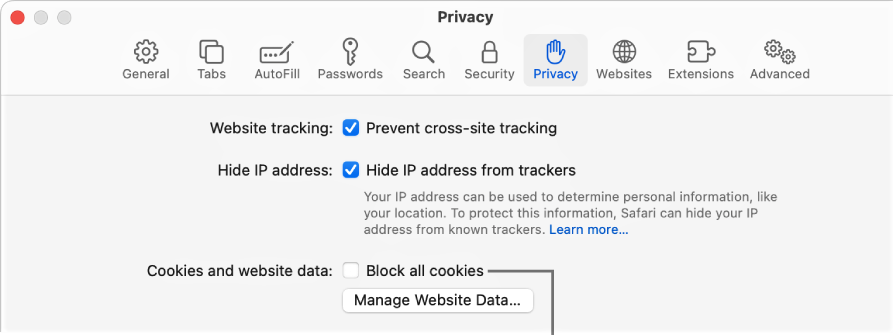
- Deselect “Block all cookies” .
iPhone and iPad (iOS 11)
- Go to your device’s Settings .
- Select Safari .
- Navigate to Privacy & Security .
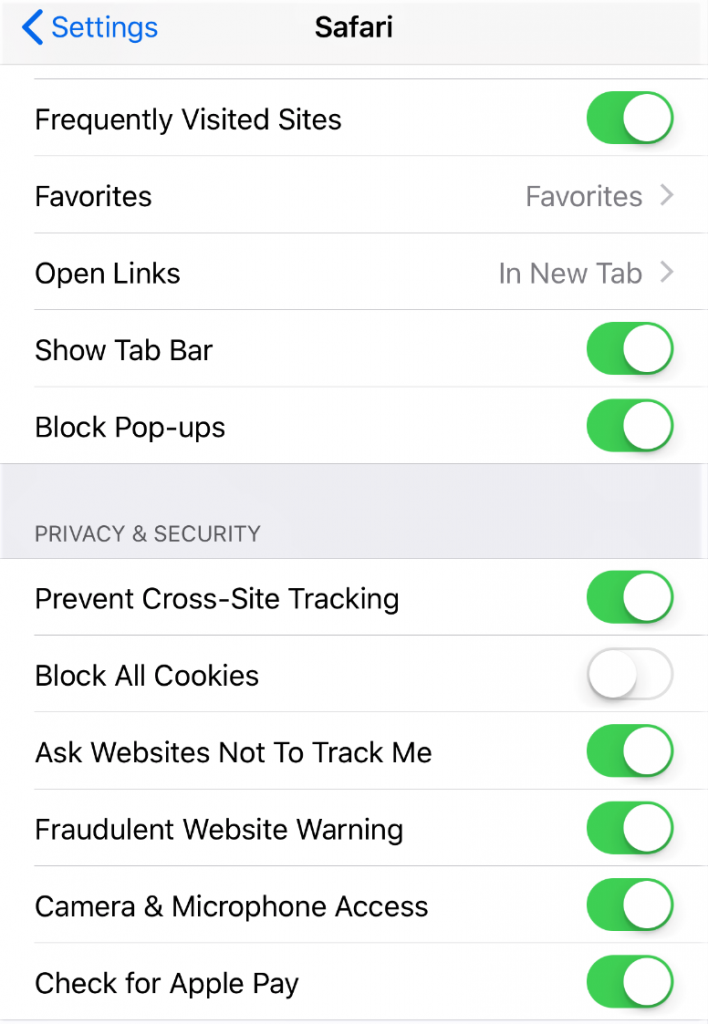
- Turn off “Prevent Cross-Site Tracking” and “Block All Cookies” .
iPhone and iPad (iOS 10)
- Select “Block Cookies” .
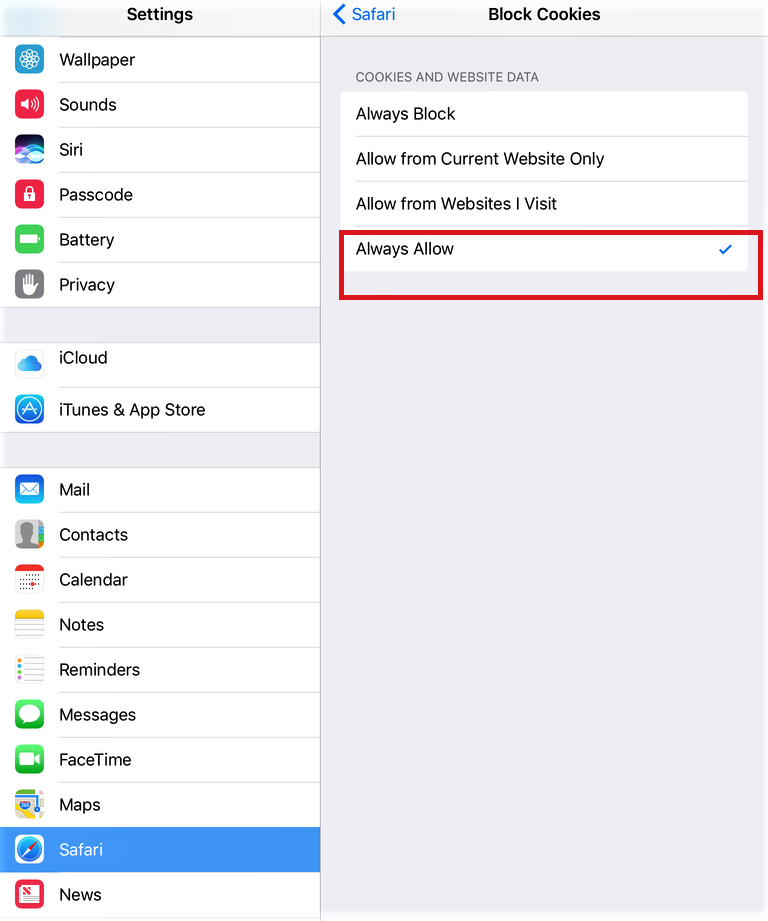
- Select “Always Allow” or “Allow from Websites I Visit” .
VPN Proxy One Pro
Here at Trend Micro, we have the perfect tool to secure your online privacy: VPN Proxy One Pro . Available for Windows , Mac , Android , and iOS , VPN Proxy One Pro gives users unlimited high-speed connections and the ability to access any content online quickly , easily , and invisibly — utilizing the resources, servers, and research from one of the global leading cybersecurity companies. Click the link to learn more and give our free trial a go.
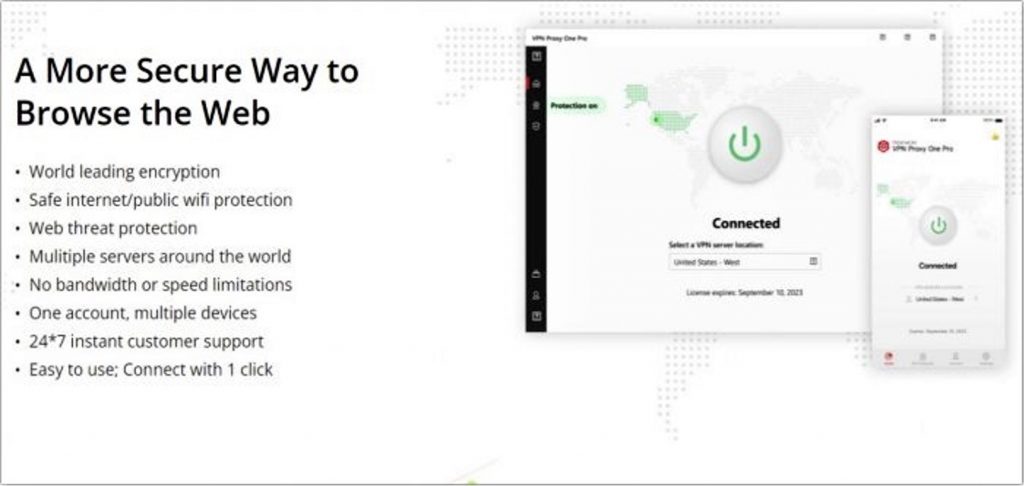
As ever, if this article has been of use and/or interest to you, please do SHARE with friends and family to help keep the online community secure and protected.
Share this article:
Was this article helpful?
Your email address won't be shown publicly.
Other Topics
You Might Also Be Interested In...

Apple Security Issues Allow Hackers to Control Your Devices — How to Update & Fix

How to Update Safari on Mac

How to Block Ads & Pop-Ups on iPhone and iPad
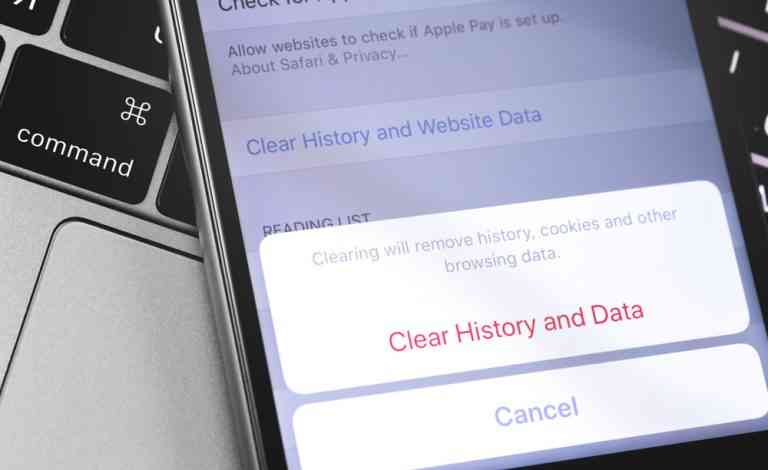
How to Clear Browsing History on Safari on iPhone & Mac

How to Clear Caches and Delete Cookies on Chrome, Safari, Firefox, Edge and I.E.
Stay updated.
Get all the latest cybersecurity news

Apply Visit Give | Alumni Parents Offices TCNJ Today Three Bar Menu
Safari, Firefox: Enable Third Party Cookies
To use access Kaltura videos from Canvas, the web browser needs to be set to accept third party cookies.
Occasionally Safari users in Canvas receive an error message when accessing embedded Kaltura media. The message states: “It seems your browser is blocking 3rd party session cookies which are required for the Kaltura application. To resolve this issue, please update your settings to allow 3rd party cookies.”
- In Safari, navigate to the page that is just before the page that contains the Kaltura media.
- Temporarily change your “Block Cookies” setting
- Open the Settings App.
- Go to Safari > Block Cookies.
- Make a note about what is currently selected.
- Select “Always Allow”.
OS X / macOS Users
- Click Safari > Preferences and click the “Privacy” tab.
- Under “Cookies and website data”, click “Always Allow”.
- Back in Safari, click the link that takes you to the page containing the Kaltura media. The media should load. If the media loads, it means that the cookie has been added to Safari and is now allowed.
- Change your “Block Cookies” setting back to its previous setting
iOS Users Open the Settings App. Go to Safari > Block Cookies. Select “Allow from websites I visit” or whatever had been previously selected.
- Select “Allow from websites I visit” or whatever had been previously selected.
TCNJ Today || Parents || Alumni
Campus Life
A-Z | Directory | Map | Offices
Facebook Twitter LinkedIn Instagram YouTube
- DemoCreator > Easy video recorder and editor for PC & Mac
- DemoAir > Online screen recording tool for everyone
- Effects Store > NEW Creative video effects for DemoCreator
- Virbo > Easily convert text into spokesperson videos
- Screen Recorder >
- Webcam Recorder >
- Voice Recorder >
- Game Recorder > HOT
- Video Presentation >
- Screen Drawing >
- Schedule Recorder >
- Video with Virtual Camera >
- Video Editor >
- Cut/Merge Video >
- Resize Video >
- Change Video Speed
- Batch Processing >
- Video Overlay >
- Audio Editing
- Online Screen Recorder >
- Online Voice Recorder >
- Online Webpage Screenshot >
- Screen Recorder for Chrome >
- Online Video Presentation Maker >
- HOT Video Editor > Take your videos to the next level
- NEW DemoCreator > Easily make a visual video presentation
- AI Avatar Video Generator > HOT
- AI Denoise >
- AI Voice Changer >
- AI Teleprompter > HOT
- AI Subtitle Generator >
- AI Speech Enhancer >
- AI Background Remover >
- AI Text to Speech > HOT
- AI Video >
- AI Voice >
- AI News >
- Hot Spot >
- Best AI Avatar Generators >
- AI Audio to Video >
- AI Virtual Friends Apps >
- Best AI Face Generators >
- Online Course >
- PPT Recording >
- Demo Video >
- Game Recording >
- Record on Windows >
- Record on Mac >
- Record on Mobile >
- Game Recording >
- YouTube Videos >
- Creative Effects >
- Audio Editing >
- Video Conference >
- Zoom Recording >
- Remote Work >
- Demo Video Tips >
- Online Class > NEW
- Teacher Skills >
- Elearning Tips >
- Lectures Recording >
- HOT DemoCreator Camp Take your videos to the next level

- User Guide >
- Video Tutorial >
- Tech Specs >
- What's New >
- Download Buy Now Download Buy Now
How To Take a Screenshot of an Entire Webpage on a Mac

- How to Record Webcam on Windows and Mac
- How to Take a Scrolling Screenshot in Windows 11/10 [7 Best Ways]
- Top Tips on How to Record Video on Windows 11
- How to Use a Screen Video Recorder in Windows 7
- Steps on How to Record Videos on Windows 8
- 7 Most Efficient Screen Video Recorders for Windows 10
- 10 Best Free Screen Recorders for PC To Capture Every Moment
- 10 Best Voice Recorder Apps for PC To Enhance Your Recording
- How to Use the Built-in Screen Recorder on Windows 10
- Top 5 Full Screen Recorder Tools for Windows 10
- Top Offline Screen Recorder for Mac OS (Free & Paid)
- How To Record a YouTube Video on a Mac – All Methods
- The Ultimate Race: Top 10 Skype Call Recorders for Mac
- How To Record the Screen With Audio on macOS
- How To Screen Record on Mac – 3 Best Methods
- The 10 Best Tools for Recording GIFs on Mac [2024]
- How To Record Videos on Mac: All Methods
- Top 10 Screen Recorders for Mac in 2024
- Screen Recorder App for PC, Android, iPhone, and Chrome
- Top 9 Best Android Apps for Screen Recording
- How To Screen Record on iPhone 13
- How To Screen Record on iPhone 14: Everything You Need to Know
- The 10 Best iOS Screen Recorders for iPhone and iPad
- How To Screen Record on iPhone 12 [Step-by-Step Guide]
- 6 Best Free Webcam Recorders
- Top 8 Secret Screen Recorder Apps in 2023
- How To Record Console Gameplay
- How to Take screenshots in Windows 11
- How to Record YouTube Videos on Your PC [Only 5 Steps]
- How to Record a Zoom Meeting
- Record Facecam on Windows 11 – Top 8 Tools to Try on Windows 11
- Best Webcam Recorder with Facial Beauty Function
- Top 10 Audio Recording Software for Mac
- Top Online Sound Recorders
- Audio Extractor: 8 Best Software to Extract Audio from Video
- 6 Best Ways to Record YouTube Audio [Easy]
- 2 Best Ways to Record Audio in Windows 11
- Top 2 Methods for Screen Recording With Audio on Windows 10
- 3 Easy Ways to Record Streaming Video
- Windows 11 Screen Recorder
- Best OBS Settings for Low-End PC
- Best Windows Game Capture Programs
- 12 Best Android Screen Recorders with Internal Audio
- 10 Best 60 FPS Screen Recorders for Windows/Mac
- Top14 HD 1080P Screen Recorders for PC
- Best Facial Recognition Software
- How To Record Audio in PowerPoint on Mac - Full Guide
- How To Record a Powerpoint Presentation With Audio and Video on Mac
Are you tired of stitching multiple screenshots of a page to capture all the information? Do you wish you could take a scrolling screenshot of a whole webpage on a Mac ? Newsflash: you can.
You can capture a screenshot of a full webpage on a Mac with several built-in tools. You can also leverage third-party solutions for added benefits (more on that shortly).
Let's see how to take a screenshot of a whole page on a Mac before exploring essential tips for managing your captures.
Table of Content
- Screenshot an Entire Webpage on Mac Using Shortcuts
- Capture a Full Webpage on Mac Using Print Page in Safari
- Screenshot an Entire Webpage Using Firefox
- Take a Screenshot of Entire Webpages on Mac With a Free Online Tool
- Capture a Full Page on a Mac With an Extension: FireShot
Change the Screenshot Location
Enable a floating thumbnail, organize screenshots with tags, 1. screenshot an entire webpage on mac using shortcuts.
The keyboard shortcuts for captures using the Screenshot toolbar (available on macOS Mojave and newer) are customizable, but we'll show you the defaults.
Here's how to take a screenshot of a full page on a Mac:

2. Capture a Full Webpage on Mac Using Print Page in Safari
Safari lets you capture an entire webpage on a Mac with a built-in Print Page option. It opens a menu for choosing a printer, the number of copies, and page orientation, but you don't have to use a printer. You can save the page as a PDF file.
Here's how to take a screenshot of an entire page on a Mac in Safari:

You can also access the Print menu in Safari by clicking File > Print or using the Command + P keyboard shortcut.

Another way to take a whole-page screenshot on a Mac using Safari is to click File > Export as PDF . That bypasses the Print menu.

3. Screenshot an Entire Webpage Using Firefox
Mozilla Firefox (available on macOS Sierra and newer) has an excellent built-in screenshot tool. Unlike Safari, it doesn't export pages as PDF but lets you download them in a PNG format.
Here's how to take a full-screen capture on a Mac and save the entire page using Firefox:

4. Take a Screenshot of Entire Webpages on Mac With a Free Third-party Tool
You may think screenshot tools have a single purpose, but they can offer more than capturing the visible or entire screen. Your Mac's built-in solutions don't go beyond their bare-bones functionality. However, their third-party counterparts have dedicated features for taking screenshots to another level.
Take your Mac's Screenshot toolbar, for example. The only way to capture an entire webpage is to zoom it out. Firefox is better because it creates scrolling screenshots and saves them as PNG images.
However, what if you don't want to use a third-party browser? You're stuck with Safari, which lets you save pages as PDF files, meaning you must convert them if you need an image format.
Enter third-party solutions. Unlike built-in tools, they have editing features, eliminating the need to switch between apps to polish your screenshots. Some even have additional functionalities for screen recording and video presentations. Wondershare DemoAir is one of them.
It has an online webpage screenshot tool for taking, editing, and saving scrolling screenshots locally or to the cloud. It also has online audio and video recorders and a solution for creating online AI video presentations. If you use Google Chrome, you'll love its browser extension for recording your screen without downloading and installing software.
Let's see how to use Wondershare DemoAir to capture a screenshot of an entire webpage on a Mac.

5. Capture a Full Page on a Mac With an Extension: FireShot
Here's how to use FireShot in Safari to capture an entire page:

How To Manage Screenshots on Your Mac
Managing your Mac website screenshots comes down to organizing them and enabling shortcuts for quick access. Here are the essential steps.
Your Mac saves screenshots on your desktop by default, but you can change the location. The process differs depending on the macOS version, so here are steps for newer and older systems.
macOS Mojave or Newer
If your Mac runs on macOS Mojave or newer, follow these steps to change the screenshot location:

macOS High Sierra or Older
If your Mac runs on macOS High Sierra or older, change the screenshot location by following these steps:
- Launch the Terminal and run this command: defaults write com.apple.screencapture location ~/[file path] . However, replace "file path" with your desired location and omit the square brackets. You can drag and drop the folder into the command line.

The Screenshot toolbar can show a floating thumbnail for every screenshot, enabling you to open and edit it in several apps or delete it without accessing its location. Here's how to enable and use it:

Tagging your screenshots streamlines your search, helping you organize and find them quickly. Here's how to add and use them to locate captures:

Taking and managing website screen captures on a Mac is a breeze with your computer's and browsers' built-in tools. However, third-party solutions like Wondershare DemoAir unlock editing features, making them a superior option. Try it for free to create high-quality screenshots of entire pages.
Does Safari have a complete page capture option on a Mac?
How much space do full website screenshots on a mac take, where are full web screenshots saved on a mac, you may also like.


IMAGES
VIDEO
COMMENTS
Always allow cookies: Deselect "Block all cookies.". Websites, third parties, and advertisers can store cookies and other data on your Mac. Remove stored cookies and data: Click Manage Website Data, select one or more websites, then click Remove or Remove All. Removing the data may reduce tracking, but may also log you out of websites or ...
Enabling Cookies on a Mac. Download Article. 1. Open Safari and click the Safari menu. While Safari is open, you'll see the "Safari" menu at the top of your Mac's screen. [1] 2. Click Preferences…. This option is near the top of the menu.
In this article, you will learn how to enable third-party cookies on Safari. Does Safari Support Third-Party Cookies? Safari is one of the most prominent web browsers currently in use. It is the default web browser for Apple devices. For security reasons, third-party cookies are blocked on Safari by default. ...
Allowing 3rd Party Cookies on Safari. Download Article. 1. Open Safari. Click the Safari app icon, which resembles a blue compass, in your Mac's Dock. [1] 2. Click Safari. It's a menu item in the top-left corner of the screen next to the Apple icon.
In just a few simple clicks, Safari can accept all third-party cookies. How to Allow Third-Party Cookies with Google Chrome. Of course, Safari isn't for everybody, so let's take a look at how ...
In the Safari app on your Mac, choose Safari > Settings, then click Advanced. Deselect "Block all cookies". Websites, third parties and advertisers can store cookies and other data on your Mac. Select "Block all cookies" to disable cookies. This may prevent some websites from working properly. See also Prevent cross-site tracking in ...
By default, Safari blocks third-party cookies for privacy and security reasons. To enable third-party cookies, uncheck the box next to "Block all cookies." This action will allow both first-party and third-party cookies to be stored on your device. Confirm the Changes: After unchecking the "Block all cookies" option, Safari will prompt you to ...
Safari users can enable cookies by going to Safari settings, navigating to the Advanced tab, and unchecking the Block all cookies box. ... Allow Third-Party Cookies in Less Common macOS Browsers As you can see, you'll generally find your cookies settings within your browser's privacy settings. If you still can't locate the appropriate setting ...
October 19, 2023 by Matthew Burleigh. You can allow cookies on your iPhone in iOS 17 by going to Settings > Safari > Advanced > and turning off the Block All Cookies option. Our tutorial continues below with more information on the iPhone Safari cookie setting, including pictures of these steps. You can also watch this video about how to allow ...
Enable 3rd party cookies in Safari. Safari is Mac's go-to browser that blocks 3rd party cookies by default. So, if you're using Safari, you can't access services that need access to those cookies. To use those services, you must allow third-party cookies in Safari, and here's how.
Enabling this option is a good step in helping prevent companies from tracking your activity online. Enabling Block all cookies will prevent block First-Party cookies, as well as Third-Party cookies. Enabling this may cause websites to not work properly, and Safari will warn you about this if you choose this option.
Please note: as of Safari 13.1 and later, third-party cookies are blocked by default. For more information, visit Webkit's article: Full Third-Party Cookie Blocking and More. Open Safari, go to the left-hand corner, and click on Safari -> Settings from the drop-down menu (Fig. 1). Figure 1
It is possible to allow usage of third-party cookies on a case-by-case basis in Firefox via browser settings. In Safari however, control is more limited — you can turn off cross-site tracking prevention, but allowing access to third-party cookies per frame can only be done at the code level, via the Storage Access API.
By Matthew Humphries. March 25, 2020. There's increasing calls for privacy online, and Apple has reacted by making Safari the first mainstream browser to block all third-party cookies by default ...
Below the Tracking preferences, click "Remember History" and then select "Use custom settings for history" option. From the custom history settings screen, click the drop-down list next to "Accept third-party cookies" and then choose "Never". Your changes will be implemented immediately, so there's no "OK" or "Apply ...
Cookies and website data are deleted unless you visit and interact with the trackers' websites. Always block cookies: Select "Block all cookies". Websites, third parties and advertisers can't store cookies and other data on your Mac. This may prevent some websites from working properly. Always allow cookies: Deselect "Block all ...
It is possible to allow usage of third-party cookies on a case-by-case basis in Firefox via browser settings. In Safari however, control is more limited — you can turn off cross-site tracking prevention, but allowing access to third-party cookies per frame can only be done at the code level, via the Storage Access API.
First-Party Cookies . First-party cookies are different in that they originate from the website you are on. They are used to improve user experience and site optimization by remembering user preferences — such as log-in details and language settings. Third-party cookies instead gather data on your behavior, such as interests, locations, and ...
Select the 'Accept' or 'Prompt' option under 'Third-party Cookies.' (Note: if you select the 'Prompt' option, you'll be prompted to click OK every time a website attempts to send you a cookie.)
To resolve this issue, please update your settings to allow 3rd party cookies.". Solution 1: Use Chrome, which is recommended over Safari to address this issue. Solution 2: Add the Kaltura cookie to Safari. Adding the cookie can be done in the following manner (iOS, OS X, macOS):
Go to Safari > Settings > Extensions and tick the FireShot checkbox in the left sidebar to activate the extension. Open the page you wish to capture, hit the FireShot icon in the Safari toolbar, and click Allow for One Day, Always Allow on This Website, or Always Allow on Every Website. Hit the FireShot icon again and click Capture Entire Page.